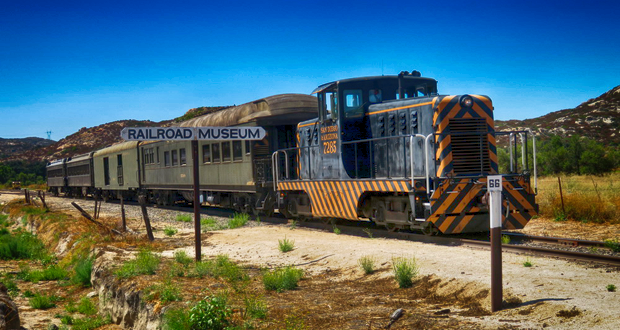Campo CA— The Pacific Southwest Railway Museum Association (PSRM), a San Diego-area historical and educational nonprofit, will mark the 100-year anniversary of the completion of the San Diego & Arizona Railway (SD&A) with a variety of family-friendly activities at its “SD&A Centennial Celebration Gold Spike Day” on Saturday, Nov. 16, at PSRM’s Campo Railroad Park and Museum in Campo, California. The public is invited to attend.

Activities for the day-long, centennial celebration of the November 1919 completion of the SD&A will include vintage train rides aboard full-size, restored locomotives and train cars from the early 20th century, live music, lectures on the history of the SD&A and activities for children, including storytelling, face painting, circus performers, medicine show performers and hay rides.
Model A and Model T Fords and Horseless Carriages will be on display, along with vintage railroad equipment, steam and diesel locomotives, passenger cars, freight cars, boxcars, cabooses and more.
Guests also will enjoy live demonstrations of a restored 1902 steam-powered firefighting pump operated by the San Diego & Arizona Eastern Railway to show how firefighters fought blazes a century ago, as well as a meet-and-greet with Dottie the firehouse Dalmatian. Also, live performances of train and western songs will be performed by the Trails and Rails Trio.
At 9 a.m. on Saturday, Nov. 16 in Campo, a ceremony will be held to unveil and dedicate a 100th anniversary commemorative plaque from the Native Sons of the Golden West.
At 1 p.m. a special gold-spike reenactment ceremony will be held.
 On display at the ceremony will be the actual “gold spike,” the original, gold-plated spike that was used 100 years ago by entrepreneur and philanthropist John D. Spreckels. Actors dressed in period clothing will pose as Spreckels and other dignitaries and civic leaders from 1919.
On display at the ceremony will be the actual “gold spike,” the original, gold-plated spike that was used 100 years ago by entrepreneur and philanthropist John D. Spreckels. Actors dressed in period clothing will pose as Spreckels and other dignitaries and civic leaders from 1919.
The reenactment ceremony will include reciting of speeches delivered on Nov. 15, 1919, when community leaders and railroad executives expressed expected contributions of the SD&A to the local economy and other factors that would improve the status of San Diego and Imperial Counties and northern Baja, Mexico.
The reenactment ceremony also will include comments from PSRM leadership, elected officials, government officials from Baja California, contemporary railroad executives and Spreckels family members. The City Guard Band will perform “San Diego Progress March,” the same song that was composed for and performed at the original gold spike ceremony in 1919.
Many activities on Nov. 16 will be free, although costs for train rides aboard full-size, restored diesel and steam locomotives and train cars will range from $14 to $28 per person. Lunch catered by Descanso Junction Café will be available for $16.50 per person. Menu will include pulled pork sandwich, gourmet hot dog, hamburger or veggie burger, plus coleslaw and french fries, soda or water.
For more information about the PSRM centennial anniversary of the SD&A, visit www.psrm.org/centennial.
Stretching 148 miles from San Diego to El Centro, including 44 miles in Mexico, the construction of the SD&A was financed by Spreckels at a cost of $18 million, or roughly $123,000 per mile. On Nov. 15, 1919 in Carrizo Gorge, Spreckels himself drove the final “gold spike.”

The SD&A rail line, which took 12 years to complete, was called the “Impossible Railroad” by engineers of its day due to the immense logistical challenges, which included extreme terrain requiring 2.5 miles of bridges and trestles and 21 tunnels, extending 11 miles through the treacherous Carriso Gorge, an area where cliffs dropped more than 1,000 feet to the bottom (17 of the 21 tunnels were located in Carriso Gorge). Additional construction challenges included floods, landslides, fires, hot weather, deaths from the flu, sabotage by Mexican revolutionaries and various delays caused by World War I.
As the final link in the nation’s transcontinental railroad system, the SD&A established a direct rail link from San Diego to the east by connecting with the Southern Pacific Railroad in El Centro. Previously, San Diegans had to travel north to Los Angeles to connect with an east-bound train. Today, parts of the railway are currently active with freight trains on both sides of the border.
The Pacific Southwest Railway Museum Association (PSRM) is a non-profit, all-volunteer educational organization dedicated to preserving the heritage of railroading and rail transportation in the Southwest with a particular emphasis on the San Diego & Arizona Railway. Since 1980, PSRM has operated the 120-acre Campo Railroad Park and Museum in Campo, Calif., where every weekend the public can enjoy vintage train rides aboard full-size, restored locomotives and train cars from the early 20th century, along with the Southwest Railway Library and more than 120 pieces of historical railroad equipment and artifacts on display. For more information on PSRM, visit www.psrm.org.
‘The Impossible Railroad,’ Centennial Celebration Day- November 16
November 12, 2019



